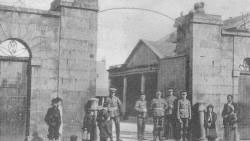Leith Fort

Leith Fort, built in the 1780s, is not to be confused with the Citadel in Dock Street built for Cromwell in 1656 or the Martello Tower built on 1809. Therein lie two other stories.
John Paul Jones, the Scot from Kirkcudbright, the founder of the American navy, sailed up the Forth in 1779 (during the American Wars of Independence) with three warships and threatened to attack Leith. The town had no defences except the weather. High winds blew up and forced the American ships out of the Forth.
A battery of nine guns was hastily erected to cover the entrance to the harbour. The authorities decided that a more substantial defence should be built and James Craig, who had won first prize for his design for the New Town, was commissioned to draw up plans for a fort in Leith.
The 1st Royal Artillery Company arrived in September 1793 to occupy the fort with a detachment of infantry from Edinburgh Castle but no guns were ever fired in anger. The fort’s first claim to fame was in 1824 when the gunners hauled their fire engine up to the High Street to help fight the ‘Great Fire of Edinburgh’.

The second was in 1861. Captains of ships anchored in the Forth set their chronometers by the ball at Nelson’s Monument on the Calton Hill but as the ball could not be seen in misty weather an audible signal was required. A gun from Leith Fort was set up on the Castle’s Half Moon Battery, connected electronically to the time ball and so the ‘One O’clock Gun’ was fired for the first time.
The Royal Army Pay Corps was the last military unit stationed at Leith Fort. It had its final official parade in April 1956.
The Fort’s interior was demolished to make way for housing. The perimeter wall, entrance gate and guardhouse were all left standing, so the view did not change much although the flats that replaced the original Georgian building look more like barracks than they did.
In April 2013 the 1960s flats were demolished to make way for new affordable housing.
Part of the original walls will be reduced in height but some will be retained at the original height.
During the month of November some archaeological excavation took place. Members of the public and local schools were invited to take part in this. While some interesting finds were uncovered it was apparent that most of the earlier material would appear to have been lost in the 1960s development.